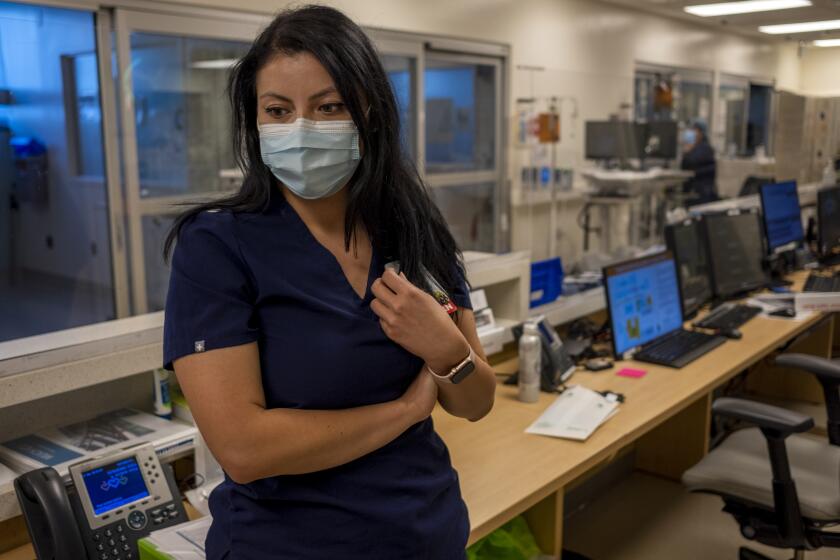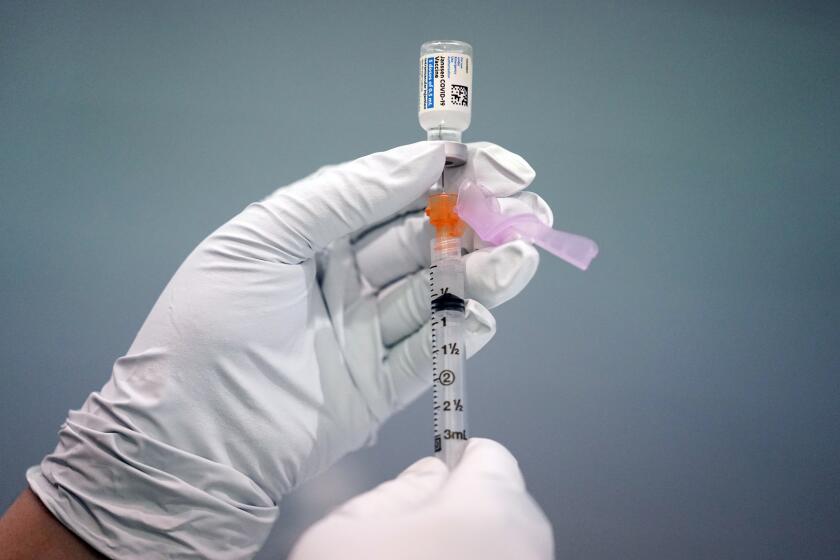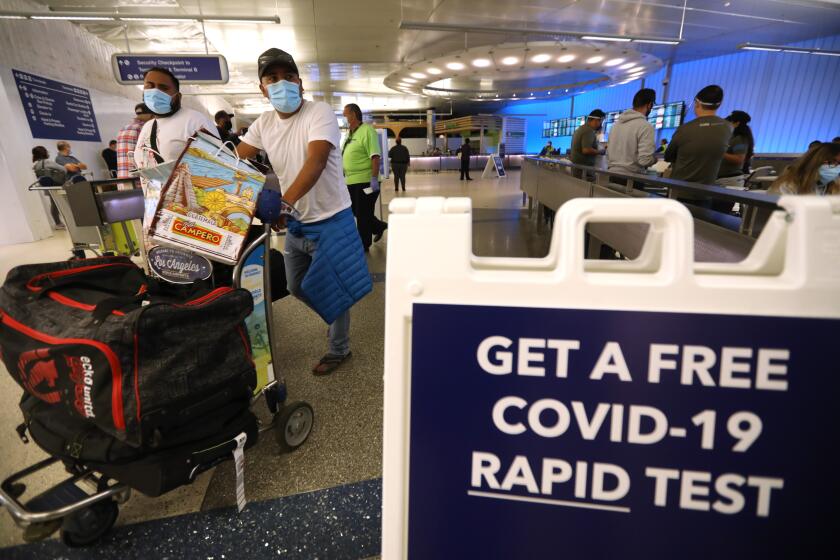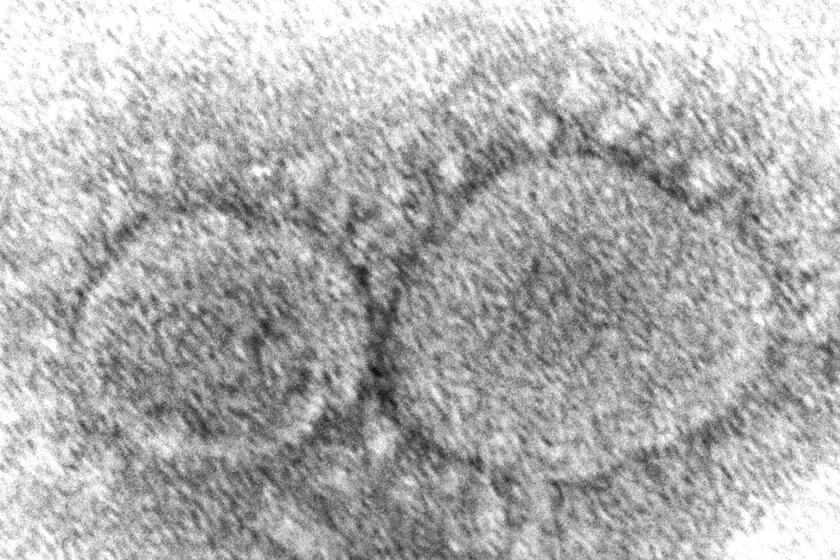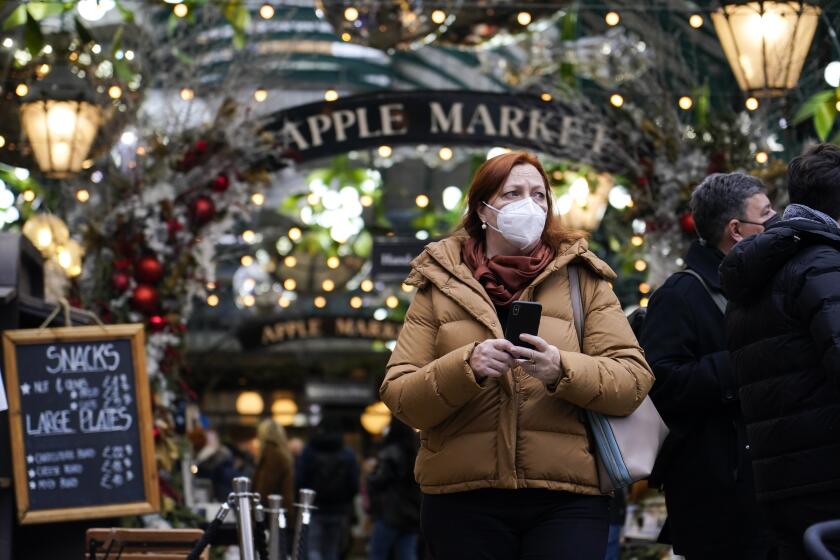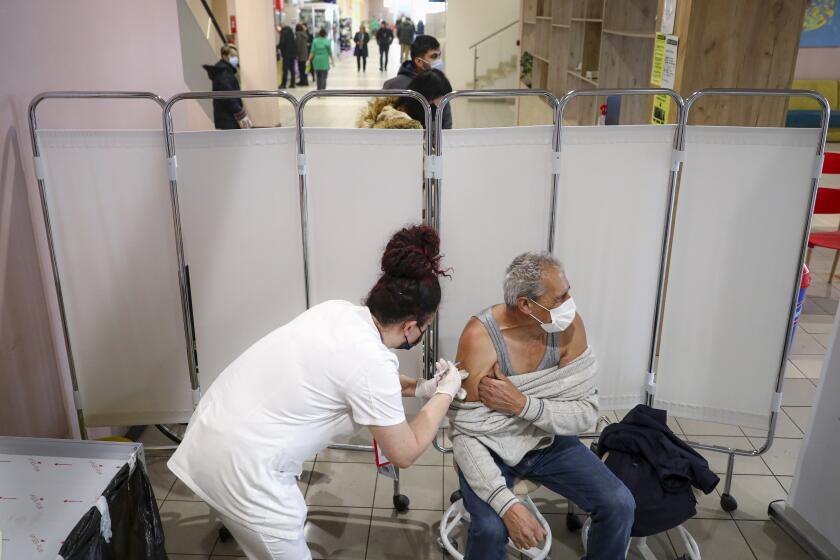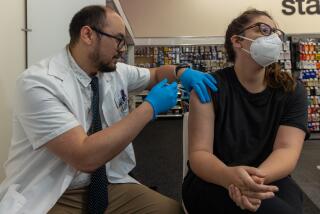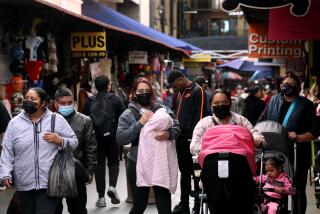‘A perfect storm’ for Delta, Omicron could overwhelm hospitals within weeks
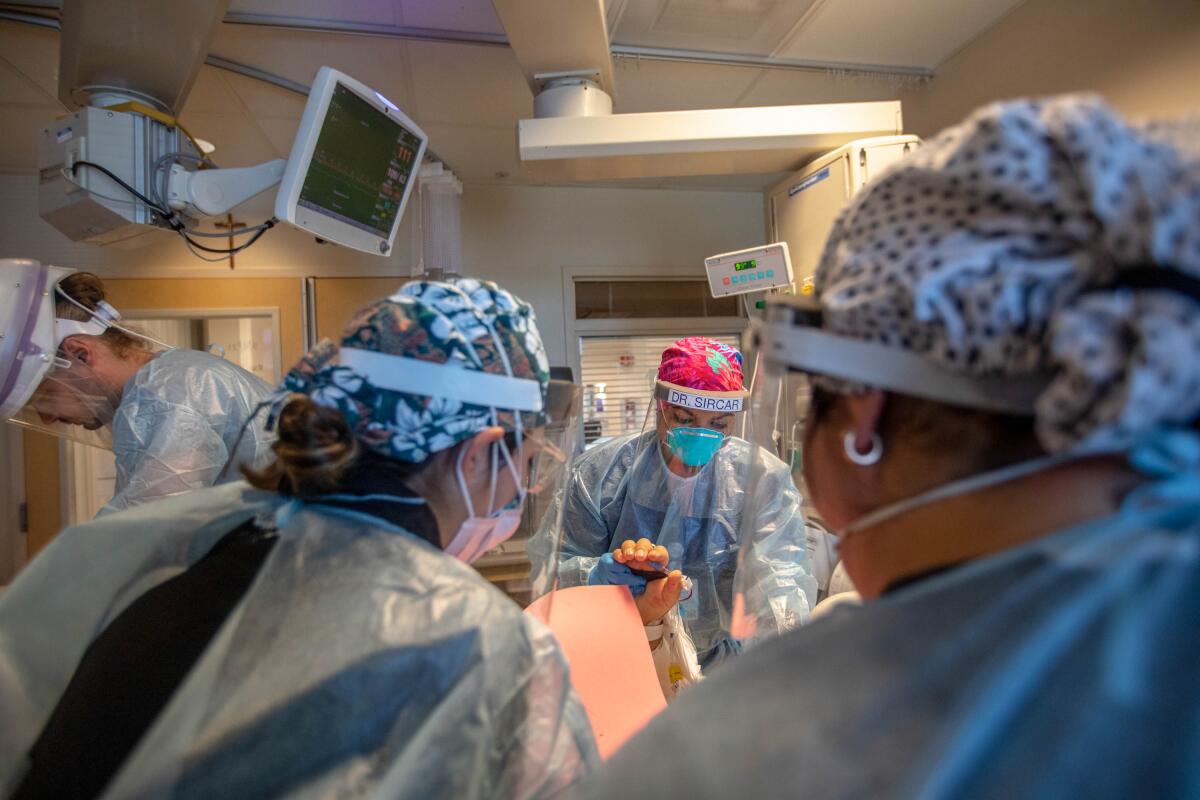
The rapid growth of Omicron is prompting officials to warn that hospitals could easily become overwhelmed, potentially within weeks, as they deal with a combination of the newest variant of the coronavirus along with patients hit by a holiday wave of the Delta strain.
California and the rest of the nation now face a formidable winter. According to the state’s COVID forecasting models, there are plausible scenarios in which a winter surge could hit hospitals worse than the summer Delta wave, which strained facilities across swaths of the state.
The combination is “a perfect storm for overwhelming our hospital system that is already strained,” said Dr. Regina Chinsio-Kwong, a deputy health officer for Orange County.
So far, the year-end spike in Delta has been nowhere as severe as the rise a year ago.
Still, hospitals face new challenges that they didn’t last year, when California ordered regional stay-at-home orders affecting most of the state. This December, hospitals are coping with a significant staffing shortage as a number of exhausted employees have left the industry while at the same time demand has risen for non-COVID-related reasons such as the flu and other healthcare needs that were put on hold earlier in the pandemic.
A rise in COVID-19 due to Omicron could result in a ‘perfect storm for overwhelming our hospital system,’ a Southern California health official says.
At Adventist Health White Memorial hospital on Los Angeles’ Eastside, “honestly, right now, our house is pretty full” with patients undergoing surgeries and other care that was delayed, said operations executive Mara Bryant.
COVID-19 patients have been few lately, but for other health issues, “we are seeing a lot of sicker patients come in because they had put off coming to the hospital during COVID. ... We’re trying to get a lot of that work caught up,” Bryant said.
If the number of COVID-19 patients swells again, the Boyle Heights hospital could activate an 80-bed field hospital built by the U.S. Army Corps of Engineers in its emergency room parking lot, Bryant said.
“The problem is getting the staffing for it,” Bryant said. Hiring from the pool of traveling nurses has been one option, but “they’re incredibly expensive right now.”
Some areas of California, including the Inland Empire and Central Valley, have relatively low vaccination rates, and some hospitals have arguably never seen substantial relief from the summer Delta surge.
The CDC now recommends Pfizer and Moderna’s COVID-19 vaccines over the J&J shot, citing the risk of rare blood clots.
In Riverside County, since the summer surge began, patients in ambulances have sometimes had to wait for many hours before entering hospitals, leaving ambulances unavailable to respond to new emergencies and delaying responses to 911 calls.
“We’ve had ambulances sit in hospitals — sometimes up to 10 or 12 deep — sometimes for five hours before the patients are offloaded from the gurneys. It is a very serious problem here,” Bruce Barton, director of emergency management for the county, said in an interview.
“It’s actually one of the largest operational threats we have to our emergency medical services system here in Riverside County.
“Even in the height of the worst of the COVID surges previously, it’s never been as bad as it has been the last four months here in Riverside County,” Barton said.
Even if a smaller percentage of people newly infected with Omicron needs hospital care, Los Angeles County Public Health Director Barbara Ferrer said, she still sees problems ahead.
“We will, in fact, see a pretty significant surge in our cases. And depending on exactly how large that increase is, it can, in fact, result in really placing way too much stress on the hospitals,” Ferrer said.
The airport expects nearly twice as many travelers as last year, reflecting a “cautious optimism” around the pandemic
Nationally, the U.S. Centers for Disease Control and Prevention forecasts there could be more than 1 million new coronavirus cases recorded the week of Christmas. By contrast, around Halloween, there were 500,000 new weekly cases.
“For [the] unvaccinated, we are looking at a winter of severe illness and death — if you’re unvaccinated — for themselves, their families, and the hospitals they’ll soon overwhelm,” President Biden said Thursday. “But there’s good news: If you’re vaccinated and you had your booster shot, you’re protected from severe illness and death — period.”
For those who are unvaccinated, getting even the first shot will help, said Biden, in remarks just after meeting with members of his COVID-19 response team.
Fragile conditions at hospitals in the Inland Empire and Central Valley, as well as the threat of Omicron, were factors in California’s decision this week to reimplement a statewide mask mandate for indoor public spaces in counties that did not already have such an order.
More cases of the Omicron coronavirus variant are reported in Los Angeles, San Bernardino and Ventura counties as new state mask order takes effect.
Even with Delta still being the dominant variant in California, COVID-19 hospitalizations are up significantly since just before Thanksgiving. Statewide, COVID-19 hospitalizations are up 16% since Nov. 24, but in much of Southern California, the increases are even worse.
Over the same period, COVID-19 hospitalizations have increased by 106% in Ventura County, 41% in San Diego County, 40% in L.A. County, 35% in Riverside County, 27% in San Bernardino County and 7% in Orange County.
The Inland Empire is seeing the greatest burden on its hospitals due to COVID-19 patients, compared with nearby counties on a per capita basis.
For every 100,000 residents, there are 19 hospitalized patients with COVID-19 in San Bernardino County, and 13 in Riverside County. The rate is 11 in San Diego County, eight in L.A. and Ventura counties and six in Orange County. Some experts say it’s a concern when the rate is five or higher.
Just in the last couple of days, there has been a shift in messaging as the pandemic outlook in Europe and the East Coast has worsened.
Globally, health officials and experts are warning against being complacent about Omicron, based on early reports suggesting it may cause milder illness. Even if the strain is less likely to cause severe illness, it is far more contagious, so infections could spike and hospitals could be overwhelmed anyway.
Having side effects after getting a COVID-19 vaccine are a sign that your immune system is responding, experts say.
Early data suggest the two-shot Pfizer vaccine’s effectiveness against symptomatic illness from Omicron falls to 35% but a booster shot brings it up to 75%. Still, this is not as good as the vaccine effectiveness against Delta, which was 95% following the booster, according to Dr. Eric Topol, director of theScripps Research Translational Institute in La Jolla.
That means, from Omicron, “we may see a lot more cases, maybe less severe disease, but the numbers are still going to be high — and hospitals will likely be in trouble,” Dr. Carlos del Rio, an infectious-disease expert at Emory University School of Medicine, said at a forum held by UC San Francisco on Thursday.
Some experts have been stunned at just how fast Omicron is spreading.
“What is most striking for me is just the rapidity of spread,” Dr. Rachel Bystritsky of UC San Francisco said at the forum.
“We were always concerned that something like this could happen, but this is beyond anything I would have thought.”
In New York, where a number of Broadway performances have been canceled due to breakthrough coronavirus infections among vaccinated people, officials are sounding the alarm.
In the New York and New Jersey areas, Omicron is estimated to account for 13% of new coronavirus cases, compared with 3% nationally.
Spiraling COVID infections in Britain driven in part by the new Omicron variant rattled many in Europe, fueling dread of another holiday scuttled.
“People are underestimating the power of Omicron because they’re saying, well, people aren’t getting really sick, they’re not in hospitals,” New York Gov. Kathy Hochul said Thursday. Using hypothetical figures, she explained:
“You may only have 1% of people infected hospitalized versus 10% from Delta, but if you have a million more people infected because it’s spread so much more quickly, that means you’ll have overflowing hospitals at this rate.”
Already, in Britain, officials recently recorded the highest number of new coronavirus cases in a single day for the entire pandemic. People there have queued up in long lines to get their booster in recent days.
Some former vaccine skeptics in Eastern Europe have shifted over to the other side as infections surge and authorities battle against disinformation.
“Even if severity was significantly lower, then the much higher transmissibility of Omicron means it still has the potential to overwhelm” hospitals, the British government’s health secretary, Sajid Javid, told Parliament this week.
France has announced plans to restrict travel from Britain.
Even health officials in highly vaccinated areas such as the San Francisco Bay Area began sounding more concerned this week about Omicron.
Omicron has now been detected in all sewage areas monitored by Santa Clara County, the home of Silicon Valley, meaning the variant “is present, at some level, in all parts of the county,” said local public health director Dr. Sara Cody.
Cody noted that highly vaccinated countries including Denmark and Norway have seen “explosive growth of Omicron.”
We’re all tired but complacency is the greatest danger in the fight against the pandemic.
“What I see is perhaps one of the most challenging moments that we’ve had yet in the pandemic. And I think it’s challenging because it’s not what we’re expecting,” Cody said. “We’ve all come to learn to live with COVID over the last two years, and we’re all a bit tired. But I want to let you know that when I look around the corner, I see a lot of COVID, and a lot of Omicron.”
Health officials say that there is no need to return to stay-at-home orders, and that holiday gatherings can be held.
Some suggested it would be less risky to hold them in smaller sizes, and among people who are fully vaccinated and boosted, adding that people should get a rapid test before meeting up.
Lin reported from San Francisco, Reyes from Los Angeles.
More to Read
Start your day right
Sign up for Essential California for news, features and recommendations from the L.A. Times and beyond in your inbox six days a week.
You may occasionally receive promotional content from the Los Angeles Times.
